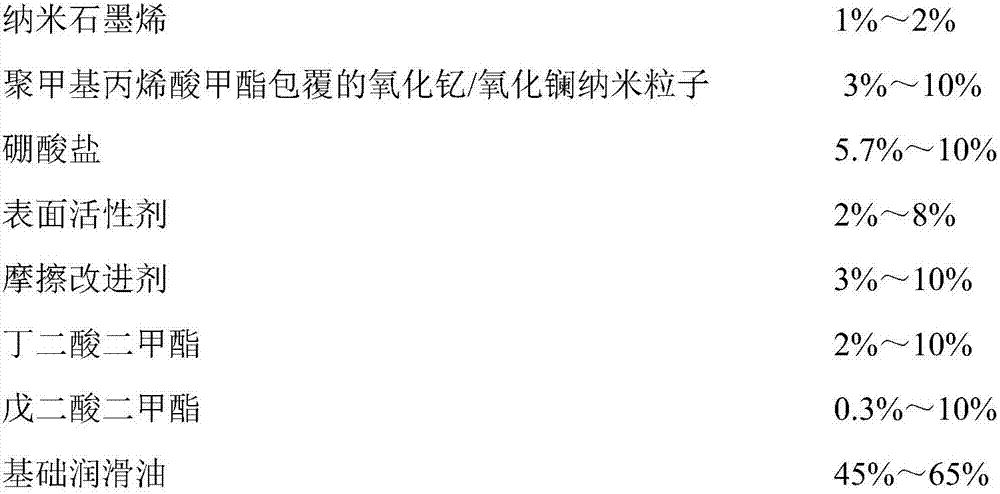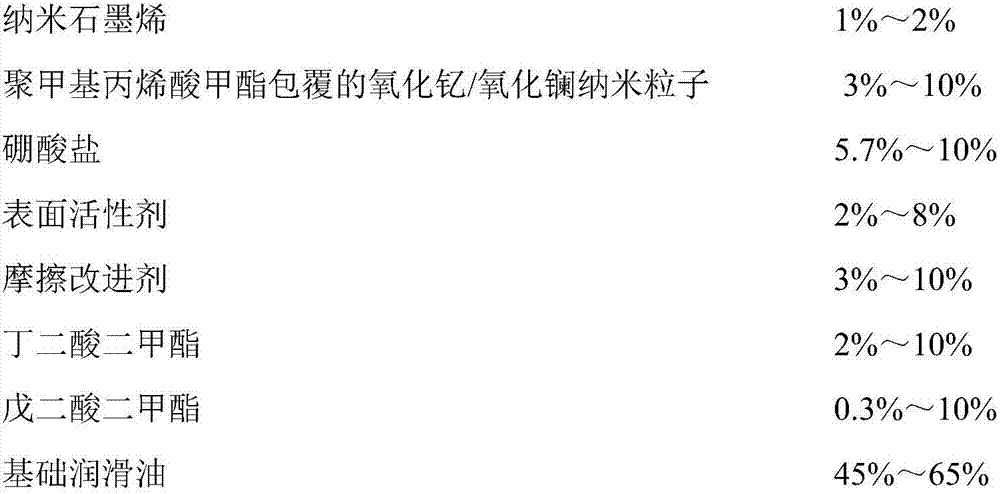Rare-earth lubricant and preparation method thereof
A technology for lubricating oil and rare earth, applied in the field of lubricating oil, can solve the problems of poor dispersion of nano rare earth oxide particles and cannot be widely used, and achieve the effect of strengthening cleaning and dispersing performance, excellent effect, and good cleaning and dispersing effect.
- Summary
- Abstract
- Description
- Claims
- Application Information
AI Technical Summary
Problems solved by technology
Method used
Image
Examples
Embodiment 1
[0044] Add 0.19g of potassium sulfate to 100mL of a mixed solution of 0.35mol / L yttrium nitrate and lanthanum nitrate with a volume ratio of 1:2, dissolve 1.2g of polyvinyl alcohol in water at 90°C, and then add 11.20g of ammonium bicarbonate to dissolve in In the polyvinyl alcohol solution, the mixed solution of yttrium nitrate and lanthanum nitrate is added therein by reverse dropwise addition. Continue to react for 1h, then age for 4h, wash, filter, and dry. Calcined at 850° C. for 2 h to obtain yttrium oxide / lanthanum oxide nanoparticles. At room temperature, 1.0 g of yttrium oxide / lanthanum oxide nanoparticles was added to 10 mL of water with a pH value of 6.0, and ultrasonically dispersed to obtain a slurry. 0.1 g of stearic acid was dissolved in 50 mL of n-butanol, and then slowly added to the ultrasonically dispersed yttrium oxide / lanthanum oxide nanoparticle slurry, stirred, and then heated to reflux for 2 h. Then filter, wash and dry. A modified mixture of yttrium...
Embodiment 2
[0047] Add 1.0g of ammonium sulfate to 400mL of 0.35mol / L yttrium nitrate and lanthanum nitrate mixed solution with a volume ratio of 1:2, dissolve 5.0g of polyvinyl alcohol in water at 90°C, and then add 50.0g of ammonium bicarbonate to dissolve In the polyvinyl alcohol solution, the mixed solution of yttrium nitrate and lanthanum nitrate is added thereto by reverse dropwise addition. Continue to react for 1h, then age for 4h, wash, filter, and dry. Calcined at 850° C. for 2 h to obtain yttrium oxide / lanthanum oxide nanoparticles. At room temperature, 10.0 g of yttrium oxide / lanthanum oxide nanoparticles were added to 100 mL of water with a pH value of 6.0, and ultrasonically dispersed to obtain a slurry. 1.0 g of stearic acid was dissolved in 300 mL of n-butanol, and then slowly added to the ultrasonically dispersed yttrium oxide / lanthanum oxide nanoparticle slurry, stirred, and then heated to reflux for 3 h. Then filter, wash and dry. A modified mixture of yttrium oxide ...
Embodiment 3
[0050] Add 0.25g ammonium sulfate to 100mL, 0.35mol / L yttrium nitrate, lanthanum nitrate solution, dissolve 1.2g polyvinyl alcohol in water at 90°C, then add 11.20g ammonium bicarbonate to dissolve in polyvinyl alcohol solution, use The mixed solution of yttrium nitrate and lanthanum nitrate was added dropwise in reverse direction. Continue to react for 1h, then age for 4h, wash, filter, and dry. Calcined at 850° C. for 2 h to obtain yttrium oxide / lanthanum oxide nanoparticles. At room temperature, 1.0 g of yttrium oxide / lanthanum oxide nanoparticles was added to 10 mL of water with a pH value of 6.0, and ultrasonically dispersed to obtain a slurry. 0.1 g of stearic acid was dissolved in 50 mL of n-butanol, and then slowly added to the ultrasonically dispersed yttrium oxide / lanthanum oxide nanoparticle slurry, stirred, and then heated to reflux for 2 h. Then filter, wash and dry. A modified yttrium oxide / lanthanum oxide nanoparticle mixture is obtained.
[0051] The mass p...
PUM
 Login to View More
Login to View More Abstract
Description
Claims
Application Information
 Login to View More
Login to View More - R&D
- Intellectual Property
- Life Sciences
- Materials
- Tech Scout
- Unparalleled Data Quality
- Higher Quality Content
- 60% Fewer Hallucinations
Browse by: Latest US Patents, China's latest patents, Technical Efficacy Thesaurus, Application Domain, Technology Topic, Popular Technical Reports.
© 2025 PatSnap. All rights reserved.Legal|Privacy policy|Modern Slavery Act Transparency Statement|Sitemap|About US| Contact US: help@patsnap.com



